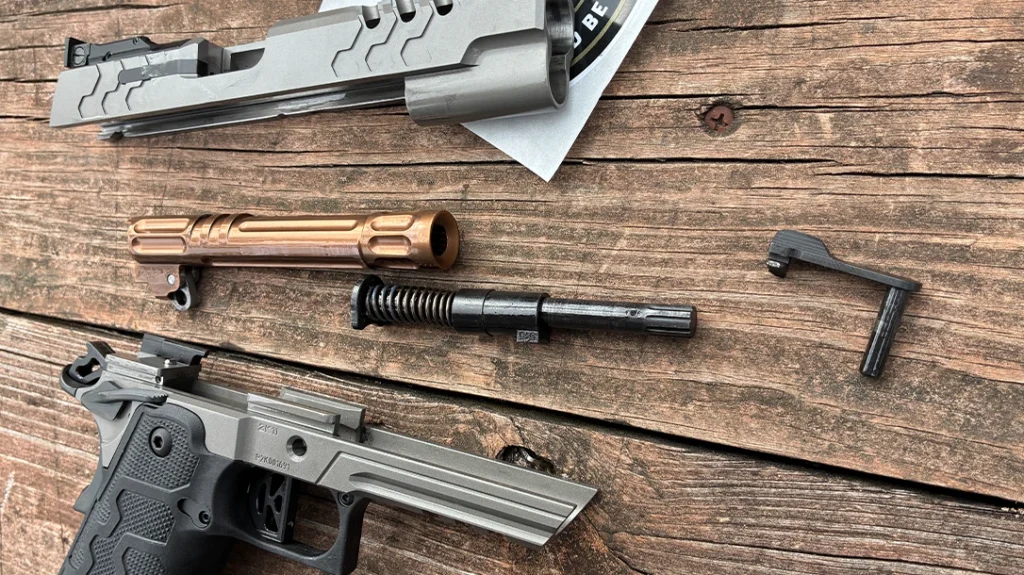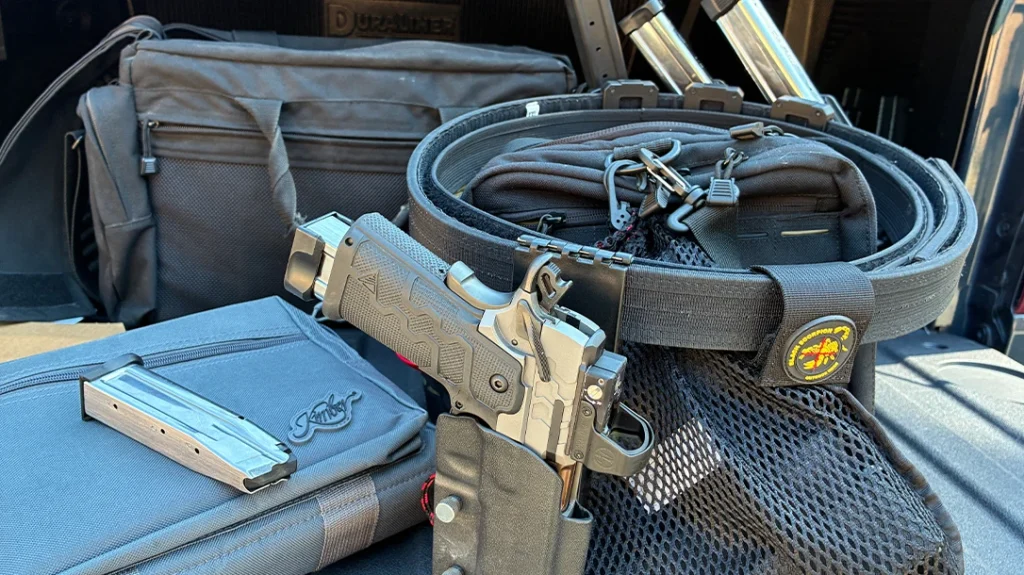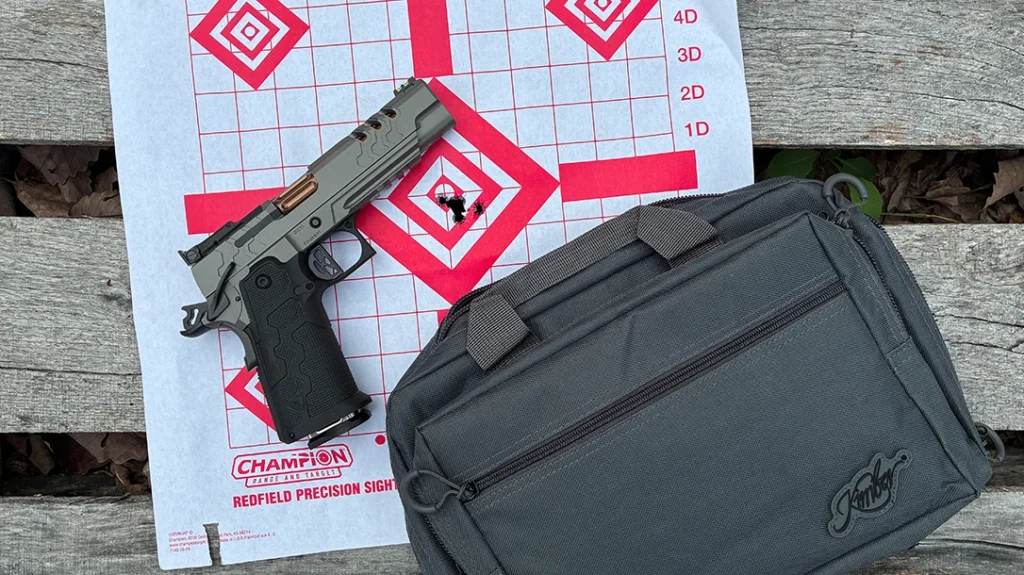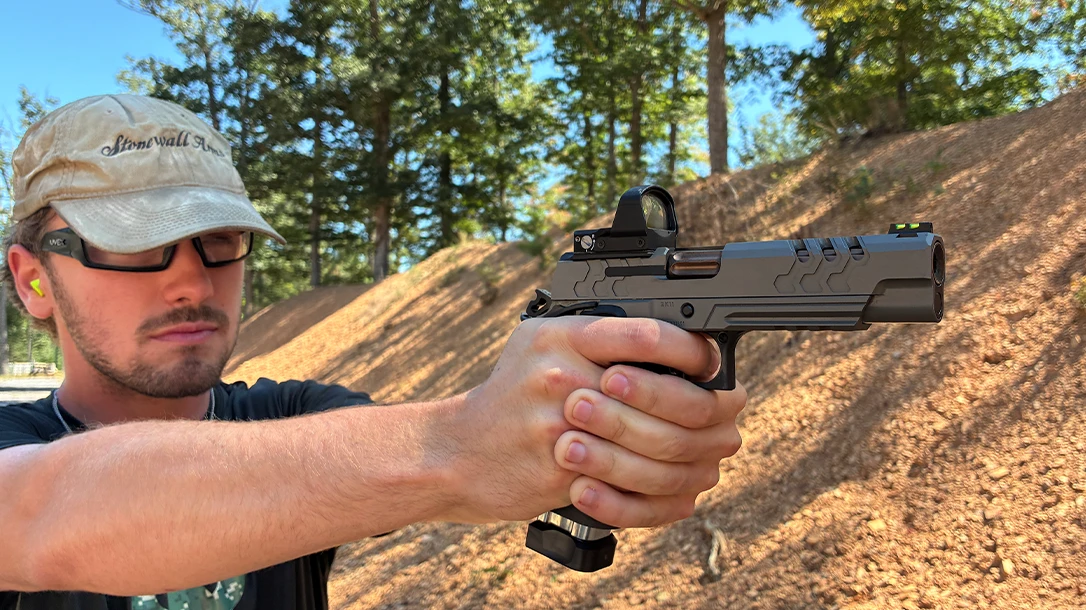What amazes me is the resurfacing of an over 100-year-old design that is now being heralded as the solution and final pinnacle of handgun performance. I am referring to single and double-stack 1911s, of course.
Over the past few years, these guns have exploded in popularity with so many different styles and manufacturers stretching from from Texas to Turkey. No doubt, it didn’t take long for the trend to roll through Illinois too.
These days, Alabama is also a double-stack hotspot. Ladies and gentlemen, meet the Kimber 2K11. Economic competition always sorts out the weak. It also rewards companies that provide products that consumers want and willingly buy.
Advertisement — Continue Reading Below
The 2K11is Kimber’s labor of love. It exhibits tight tolerances. It gets built one at a time by talented people. These single-action pistols also come with awesome single-action triggers and other enhancements. Thus, they qualify as a premier rendition of what modern double-stack 1911s can offer. Kimber’s philosophy is to combine the highest quality raw materials, the best CNC equipment, and well-thought-out components. On top of the many unique features that 2K11s bring to the table, they’re also available in .45 ACP–something hardly any mainstream double-stack manufacturer offers anymore.
Heart Of The Kimber 2K11
The Kimber 2K11’s frame follows the traditional double-stack 1911 frame pattern. It consists of a modular two-piece design which includes a steel chassis mated to a grip. Depending on the maker or the gunsmith that builds them, these grips tend to be polymer or aluminum. The 2K11 Stainless Target possesses a stainless-steel frame that’s fitted to a Kevlar / carbon-fiber grip module from MJD. Keep in mind that different Kimber 2K11 variants use different materials in their grips, like aluminum.
Advertisement — Continue Reading Below
The 2K11’s steel chassis contains the rails that the slide interacts rides on, the fire control group, thumb safeties, grip safeties, slide stop and railed dust cover. The 2K11’s slide is CNC-machined, heat-treated stainless steel. The stainless-steel slide features angled front and rear slide serrations along with attractive lightening slide cuts. While aesthetically satisfying, these details are not mere window dressing. These cuts serve both to increase slide purchase for manipulation and to balance the slide as it reciprocates. All Kimber 2K11 metal components are DLC coated.
2K11: Like A 1911, But Better
Double-stack 1911 grips can be a dicey topic. Due to their magazine geometry, they can be rather thick. In the 2K11’s case, Kimber sagely decided to keep the classic 1911 grip angle–it’s part of the myth, after all. However, in order to avoid that extra chunkiness, Kimber’s approach to grip construction resulted in a relatively thin front strap and sidewalls. This provides ergonomic dimensions more closely comparable to the typical single-stack 1911 while still maintaining twice the capacity.
In simple terms it means you don’t need massive mitts to comfortably run and handle the Kimber 2K11. Compared to that single-stack gun, the 2K11 only has a .25-inch difference in circumference in width and front-to-back measurements in the grip.
Advertisement — Continue Reading Below
The Kimber 2K11 Stainless Target ships with a single 17-round and two 20-round magazines. Its magazines aren’t proprietary, they fit the classic 9 mm / .38 Super double-stack profile. It’s the same spec that many of the big names or high-end gunsmiths use.
Thankfully, the days of needing to “tune” 2011 competition weapons and magazines are over. Kimber 2011 magazines are meant to function out of the box.
Kimber has improved the internal magazine well geometry for enhanced reliability. Plus, the Kimber 2K11 frame features a proprietary shoulder that prevents over-insertion of the magazine. If you have ever hastily inserted a magazine during a reload while training or competing, you know how important this is. Not only can this cause a malfunction with the slide going forward, but you can also damage your ejector.
Advertisement — Continue Reading Below
Sum Of Its Parts
Nice-shooting triggers represent a great deal of why shooters gravitate around double-stack pistols. They reward shooters, and the Kimber 2K11’s Stainless Target’s single-action GT Match trigger is no exception. Its trigger pull is factory-calibrated to break at a cool 3.5 pounds. It is a work of art with no creep and minimal reset distance.
Other performance-enhancing features found standard on the 2K11 Stainless Target include oversized ambidextrous thumb safeties, a high-grip beavertail safety, a palm pad and an extended external ejector. This particular 2K11 variant weighs 35 ounces.

Advertisement — Continue Reading Below
The Business End
2K11 Stainless Target models are also built around 5-inch ramped and fluted PVD-coated bull barrels. Underneath their barrels, these pistols are assembled with Kimber’s unique toolless guide-rods. This model has a 10-lb recoil spring. The neat thing about these toolless guide-rods is that the guide-rod can be dismantled easily. Simply lock the slide to the rear, and give the end of the guide rod a twist to relieve spring pressure for easy field stripping. That’s it.
Adding A Red-Dot
The 2K11 Stainless Target comes with an adjustable rear sight. It does double-duty and also serves as cover plate to the pistol’s optic-ready factory cut slide. With convenience in mind, this 2K11 Target Stainless shipped with a Trijicon RMR footprint optic adapter plate from C&H. Naturally, other footprint optic plates are available from Kimber.
I ended up using a Leupold DeltaPoint Pro, a red-dot sight that I’m a fan of.I first took note of the Leupold DeltaPoint Pro (DPP) red-dot sight nearly a decade ago. There were several reasons, but the most prominent being its 2018 involvement with the US Marshal Service’s Special Operations Group (SOG) handgun package. Leupold products consistently warrant consideration due to their inherent quality and thorough R&D.
Advertisement — Continue Reading Below
I really enjoy the Delta Point Pro’s convex aspherical DiamondCoat2 lens treatment versus a concave lens/housing design. This shape offers an enhanced non-distorted field of view. I’ll concede that it can be hard to convey what a difference this makes. It’s subtle, because there’s not much between the slightly upward curve versus the downward. But do I urge readers with any doubts to compare products side by side to see for themselves. The Leupold Delta Point Pro’s aircraft-grade aluminum housing is further reinforced by a surrounding steel shroud for extra protection and durability.
Loading Up At The Range
Once out on the range, I found the Kimber 2K11 Stainless Target mounted with the Leupold DeltaPoint Pro, one of the easiest red-dot equipped handguns to adapt to.
It’s so easy-shooting, I took to it in no-time. Thanks to the fact that Kimber’s frame and grip module maintain the classic 1911-grip angle, the Leupold DeltaPoint Pro’s 2.5 MOA red dot is “just there” upon presentation. I shot some drills that consisted of speed-drawing from the holster to see just how quickly I could find the dot was easy. I also knocked down plate racks to the point where it became monotonous. It wasn’t long before all my ammo went up in smoke and I littered the range with spent brass.
I also ran the gun in a couple of scenario-based exercises that involved engaging targets from behind cover or on the move. Afte that, I added more magazine / reload drills for two reasons. First, I wanted to get a feel for manipulating the Kimber 2K11 Target. Second, I continued to evaluate how quickly I could visually pick up the dot after bringing the gun back into my working space and on target.
Match O’Clock With The 2K11

Once the Origin Shooting Outlaw Steel Match was scheduled at Echo Valley Training Center, I signed up post haste. With the Leupold DeltaPoint Pro zeroed, I was ready to rock the gun at this steel match. I had the support of my existing stockpile of double-stack magazines and my Black Scorpion competition rig, so this match opportunity was too good to pass up.
It was during my match that I noticed how the Kimber 2K11’s slide seems to operate on ball bearings. The slide moves so fluidly that the Leupold red-dot tracks smoothly during recoil. It’s almost as if the red-dot is never out of your vision.
There’s something about the way that Kimber tunes the 2K11 in order to allow the slide’s recoil energy to be expended before it hits home. To elaborate, during the process of stripping a new round off the magazine, you can feel the slide coming forward more gently and with a fraction of the force typical of typical recoil spring setup.
Naturally, this reduces the slide slamming forward which also curtails the gun’s muzzle dipping. Trust me, when you’re trying to strike steel as fast as you can, that muzzle flip becomes quite noticeable.
Of course, slowing down the slide also translates to softer felt recoil, helping you to keep follow-up shots on target or transitioning to the next one. Four stages and 200 steel plates later, the match was over. I encountered nary a reliability issue during my frenzied match shooting pace. In fact, it felt like I was letting the Kimber 2K11 Stainless Target down at times. During shooting, I could sense that the 2K11 wanted to go even faster, but my abilities wouldn’t allow me.
Raison d’être
The Kimber 2K11 in either 9 mm or .45 ACP represents portability, capacity, reliability, and controllability—the poster child traits for a duty, tactical, competition, or personal defense handgun. Kimber is so bullish on the 2K11, that it recently rolled out the 2K11 PRO series, full-profile 2K11s with shorter commander-size slides.
Anyone who knows 1911s has heard of Kimber. The company has been well- established in the single-stack universe for over 45 years. That it decided to branch out into modern double-stack 9 mm designs is a benefit of handgun connoisseurs. During this review, it was quite evident that Kimber did not rush the 2K11’s development haphazardly.
Kimber 2K11 Target Stainless Specifications
- Make: Kimber
- Model: 2K11 Stainless Target (OR)
- Caliber: 9mm (also available 45ACP)
- Magazine Capacity: One 17-round and two 20-round magazines arrive with the pistol
- Barrel Length: 5 inches
- Overall Length: 8.56 inches
- Height: 5.74 inches
- Weight Empty: 35 ounces empty
- MSRP: $2245
Performance

| Federal 124-grain HST | |
| Average Velocity | 1,149 FPS |
| Best Group | 2.00 inches |
| Hornady 147-grain XTP | |
| Average Velocity | 982 FPS |
| Best Group | 2.25 inches |
| Black Hills 115-grain FMJ | |
| Average Velocity | 1,205 FPS |
| Best Group | 2.50 inches |
| Black Hills 124-grain JHP | |
| Average Velocity | 1,190 FPS |
| Best Group | 1.50 inches |
Accuracy test consisted of three five-shot groups with each ammunition type, with Leupold DeltaPoint Pro mounted; group sizes were averaged. Velocity figures obtained by averaging five rounds fired over a Garmin Xero C1 Pro chronograph.
WHY OUR ARTICLES/REVIEWS DO NOT HAVE AFFILIATE LINKS
Affiliate links create a financial incentive for writers to promote certain products, which can lead to biased recommendations. This blurs the line between genuine advice and marketing, reducing trust in the content.


